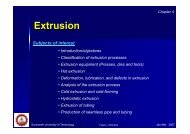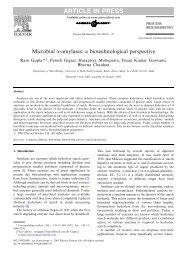Protein engineering from a bioindustrial point of view
Protein engineering from a bioindustrial point of view
Protein engineering from a bioindustrial point of view
Create successful ePaper yourself
Turn your PDF publications into a flip-book with our unique Google optimized e-Paper software.
422 <strong>Protein</strong> <strong>engineering</strong><br />
computer-aided design and structural mutants. <strong>Protein</strong> Eng<br />
1996, 9:507-51 Z<br />
The combination <strong>of</strong> modeling with site-directed mutagenesis allows a de-<br />
tailed picture <strong>of</strong> the reaction mechanism <strong>of</strong> a lipase to be developed. Many<br />
similarities with serine protease are seen. The added feature <strong>of</strong> inter-facial<br />
activation is not covered here.<br />
47. Brady I, Brzozowsi A, Derwenda Z, Dobson G, Tolley S,<br />
Turkenburg J, Christiansen L, Huge-Jensen B, Norskov L, Thim L,<br />
Menge U: A serine protease triad forms the catalytic centre <strong>of</strong><br />
a triacylglycerol lipase. Nature 1990, 343:767-770.<br />
46. Martinelle M, Holmquiest M, Clausen IG, Patkar S, Svensen A,<br />
. Huh K: The role <strong>of</strong> glu67 and trp89 in the lid <strong>of</strong> Humicola<br />
lanuginose lipase. <strong>Protein</strong> Eng 1996, 9519-524.<br />
This provides a complementary study to reference [471 focusing more on<br />
mutations affecting enzyme-substrate interactions.<br />
49.<br />
50.<br />
51.<br />
52.<br />
Svensen A: <strong>Protein</strong> <strong>engineering</strong> <strong>of</strong> microbial lipases with<br />
industrial interest In Enzyme Technology for industrial<br />
Applications. Edited by Savage L. Southbourough MA: IBC<br />
Biomedical Library Series; 1996:91-97.<br />
Pedersen S, Lange KN, Nissen AM: Novel industrial enzyme<br />
applications. Ann NY Acad Sci 1995, 750:376-390.<br />
Reinikainen T, Teleman 0, Teeri lT: Effects <strong>of</strong> pH and high ionic<br />
strength on the adsorption and activity <strong>of</strong> native and mutated<br />
Cellobiohydrolase I <strong>from</strong> Trichoderma reesei. <strong>Protein</strong>s 1995,<br />
22:392-403.<br />
53. Koivula A, Reinikainen T, Ruohonen L, Valkeajawi A, Claeyssens<br />
. M, Teleman 0, Kleywegt GJ, Szardenings M, Rouvinen J,<br />
Jones TA, Teeri lT: The active site <strong>of</strong> Trichoderma reesei<br />
cellobiohydrolase II: the role <strong>of</strong> tyrosine 169. <strong>Protein</strong> Eng 1996,<br />
9:691-699.<br />
This paper provides a look at the more intimate details <strong>of</strong> the catalytic chem-<br />
istry <strong>of</strong> cellobiohydrolase II <strong>from</strong> Trchoderma reesei. Together references<br />
[51] and [!%*I provide a good perspective <strong>of</strong> the global and local variables<br />
important in cellulase catalysis.<br />
54. Jeffries TW: Enzyme technology for pulp bleaching and<br />
deinking. In Enzyme Technology for industrial Applications Edited<br />
by Savage L. Southbourough MA: IBC Biomedical Library Series;<br />
1996:61-97.<br />
55. Jeffries TW: Biochemistry and genetics <strong>of</strong> microbial xyianases.<br />
Curr Opin Biotechnol 1996, 71337-342.<br />
;his paper provides a description <strong>of</strong> the major xylanase families, the im-<br />
portant regions in substrate binding and catalysis, data on stability and pH<br />
dependence <strong>of</strong> activity, as well as some discussion <strong>of</strong> comercial applications.<br />
As such it provides a good starting <strong>point</strong> to gain a perspective on microbial<br />
xylanases.<br />
56. Lawson SL, Wakarchuk WW, Withers SG: Effects <strong>of</strong> both<br />
. shortening and lengthening the active site nucleophile <strong>of</strong><br />
Bacillus circu/ans xylanase on catalytic activity. Biochemistry<br />
1996, 35:lOll O-l 0116.<br />
Linder M, Salovuori I, Ruohonen L, Teeri TT: Characterization The hydrolysis <strong>of</strong> glycosidase bonds can proceed by two mechanisms that<br />
<strong>of</strong> a double cellulose-binding domain. I Biol Chem 1996, are critically dependent upon the distance separating the carboxyl groups. In<br />
271:21266-21272.<br />
this work, the catalytic consequences <strong>of</strong> changing this distance are explored.










